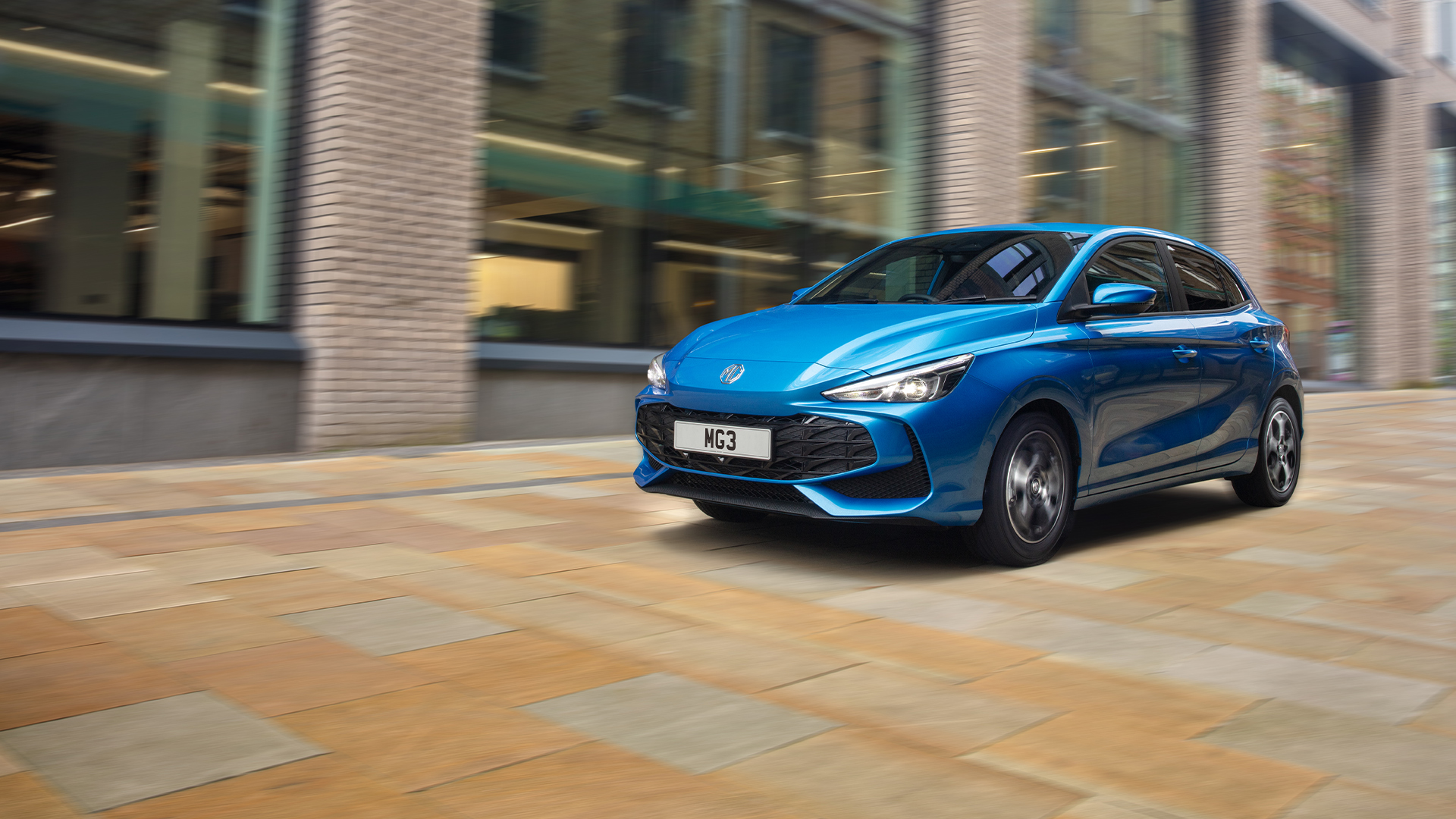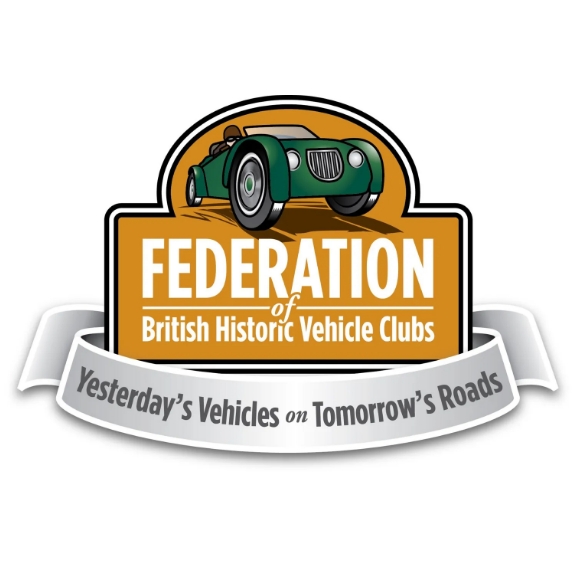Reproduction in whole or in part of any article published on this website is prohibited without written permission of The MG Car Club.
Peking to Paris 2013 by MG
By Rhys Timms
The MGCC China invited us to their home in Shanghai prior the commencement of the 2013 Peking to Paris Endurance Rally in Beijing. MG was represented in this rally by two crews of Rhys Timms/James Stone and Dr Peter Zernial/Udo Fink, in an MG SA and MG TC respectively. The China club had publicised our visit widely, and we were greeted by many members over a whole day’s and night’s activities. We were impressed with one couple who had driven five hours in their MG to meet us.
We commenced our Shanghai visit with an MG tour, specifically organised for us through the sights and sounds of Shanghai – by sportscar of course. We were offered many rides with club members, which we gladly accepted, and had more than 20 MGs to choose from to be a passenger. The oldest MGs in the cavalcade were English made MGFs imported into China, and the newest were MG3s and MG6s straight off the production line in Shanghai.
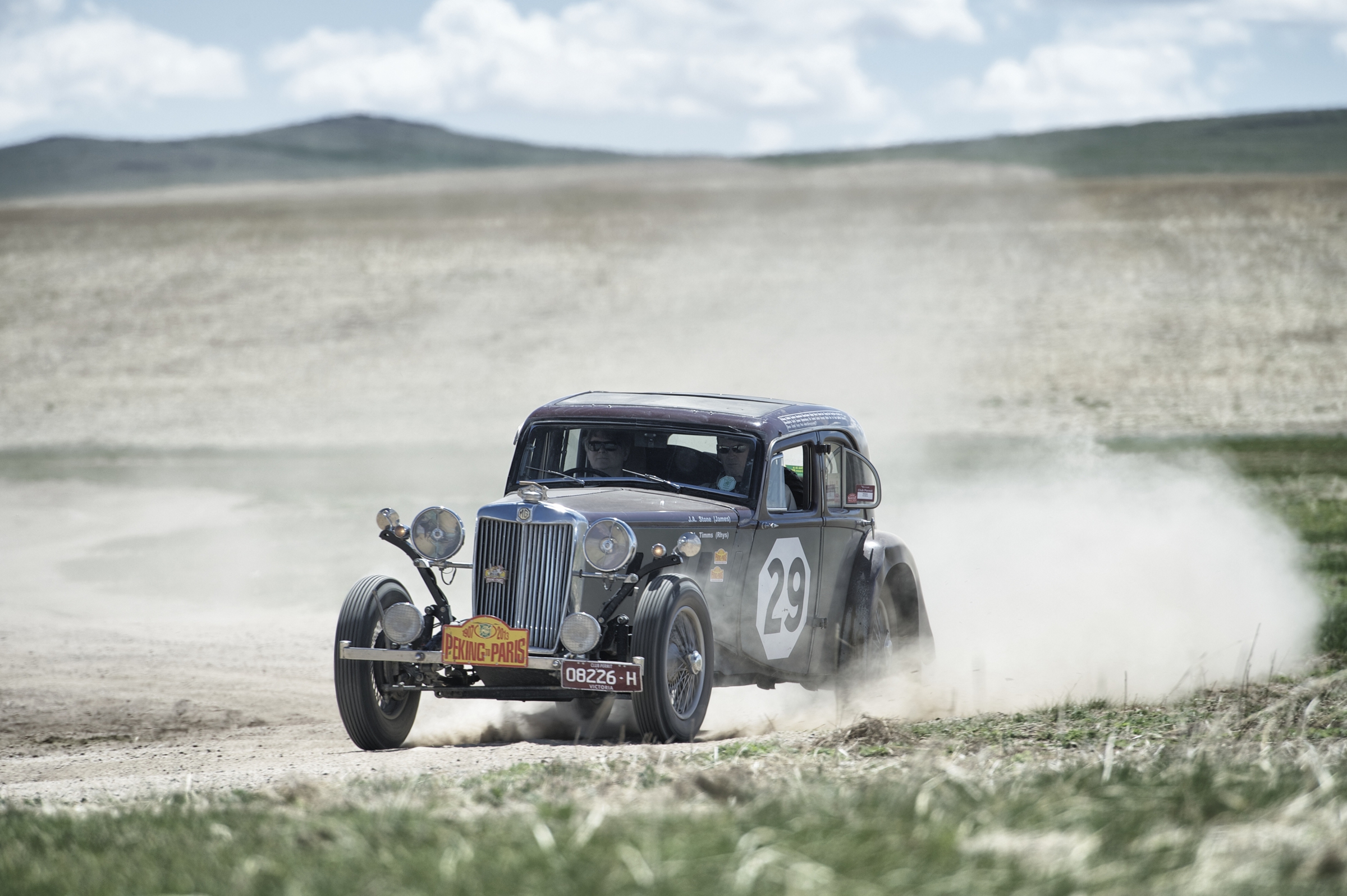
Our tour ended at the Green Room, the new clubrooms of the MGCCC. The club has accumulated a significant amount of memorabilia in the short time since its incorporation, and we were very honoured to be guests in their clubrooms. A huge surprise greeted us: some of the photos we had sent to the club secretary Mr Shen to introduce ourselves, ended up on giant sized posters in the clubrooms, with our biographies written in Chinese. Despite the language barrier, we were able to communicate easily, and the interpreter we hired wasn’t even necessary.
After a cool drink and a tour of the clubrooms, we were invited to a banquet meal hosted by the MG Car Company (SAIC) with club members at a traditional farm restaurant near the MG clubrooms. A feast it was, following this, we had a party back at the Green Room. The MG Club in China is thriving, and the passion for the marque is very strong. We ended the evening exchanging gifts with each other, but alas we were on a schedule, and were off home late (and one couple of course still had five hours to drive back home).
A fast train ride to Beijing, and one day later we picked up our MGs from a logistics warehouse in Beijing. At the warehouse, we met the rally director, and he professed that he used to own an MG VA Tickford, and had very fond memories of this car. He currently owns an MG TC hidden in his garage, so we hoped for a little MG support from high up.
Instead of following the route book back to the hotel, we made a diversion to an MG dealer on the other side of Beijing who had opened on a Sunday for us, organised by the MGCCC, to put our cars up onto a hoist, and a last spanner check and look over. A fellow rally car followed us assuming we knew the way to the hotel, and would save him thinking with his first encounter with tulip diagram navigation and Beijing driving.
Rally rule number one – don’t follow the car in front. Once again our hosts were very generous, and the MG Roewe dealer provided a ‘banquet’ afternoon tea for us, as well as their mechanics assisting us with our tasks. We accidentally blew a fuse to the fuel pump when tidying up the wiring, and we didn’t realise until the floats in our carbs ran out of fuel when we idled out onto their forecourt – our first breakdown. And a lucky portent, each time we broke down it was in front of a garage or workshop.
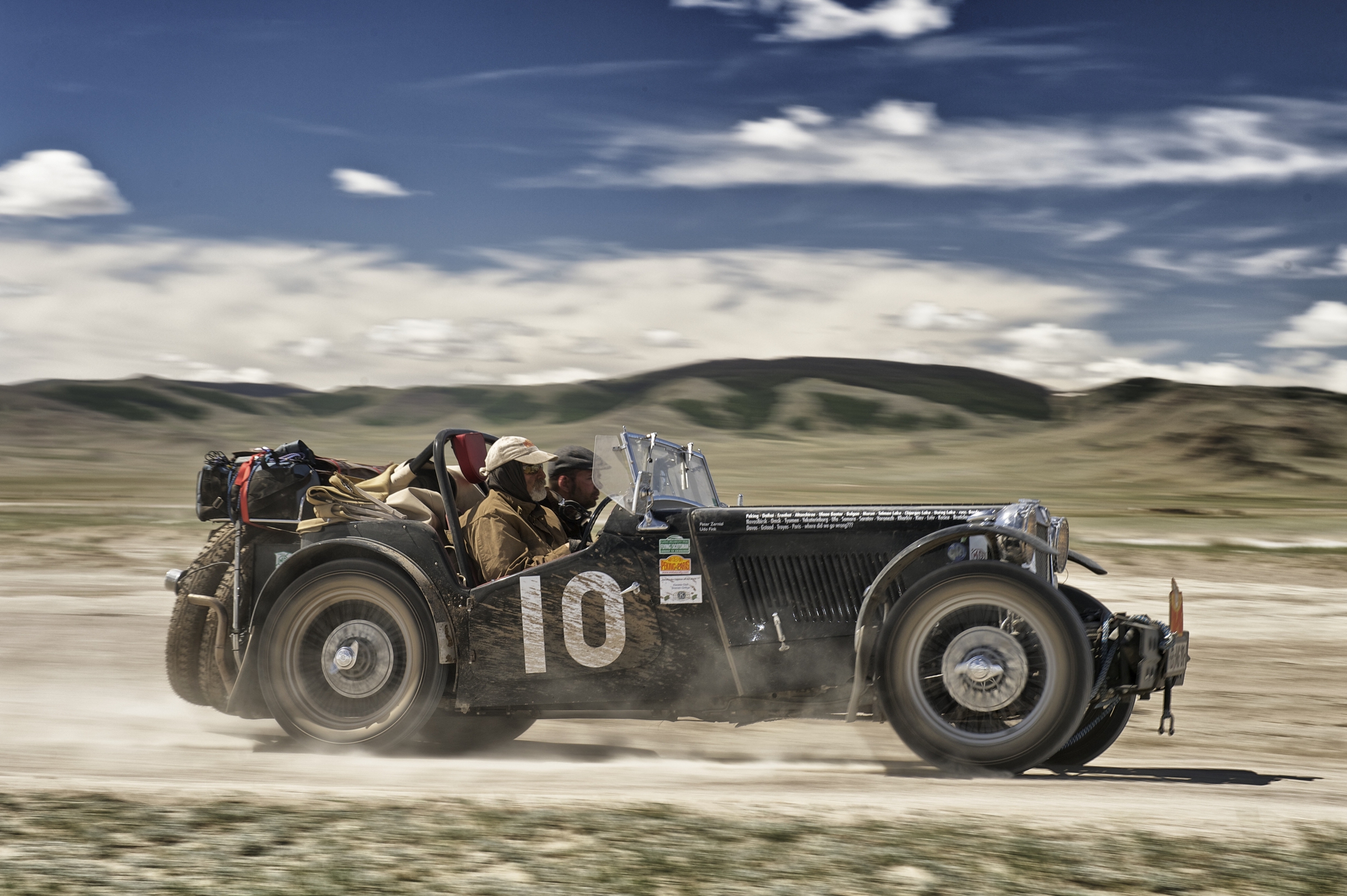
After registration, scrutineering and getting our provisional Chinese drivers licence, we found ourselves a day later at the Great Wall of China, farewelled off by family and two very eager members of the MGCC. Both club members were from Shanghai and flew up to help us, not only at the MG dealer in Beijing, but then to wave us off. Drums, Dragons and a marching band (playing Gangnam Style!) was a fitting start as the 96 cars of ‘pre war’ or ‘pre 1975 classic’ origin were flagged off.
The first two days of the rally in China was supposed to be two days of familiarisation, as the Chinese authorities did not want us being a nuisance in rally mode. However, a storm water drain that overflowed soon gave us taste of the rally on the first day with a one metre deep flood to fjord for 50 metres. Several cars succumbed to electrical issues, stopped in the middle of brackish dirty grey sewer looking (and smelling) muck.
Not us, but two other English cars (named after a big cat), succumbed to the water – Joe Lucas, you never imagined that. Soon after this welcome, we hit the road from hell. The only option was to idle in first gear for the next 90 minutes to traverse 20 kilometres. Lots of suspension weaknesses were highlighted at this stage for the whole rally field. Looking back, this was probably the worst stretch of road we encountered.
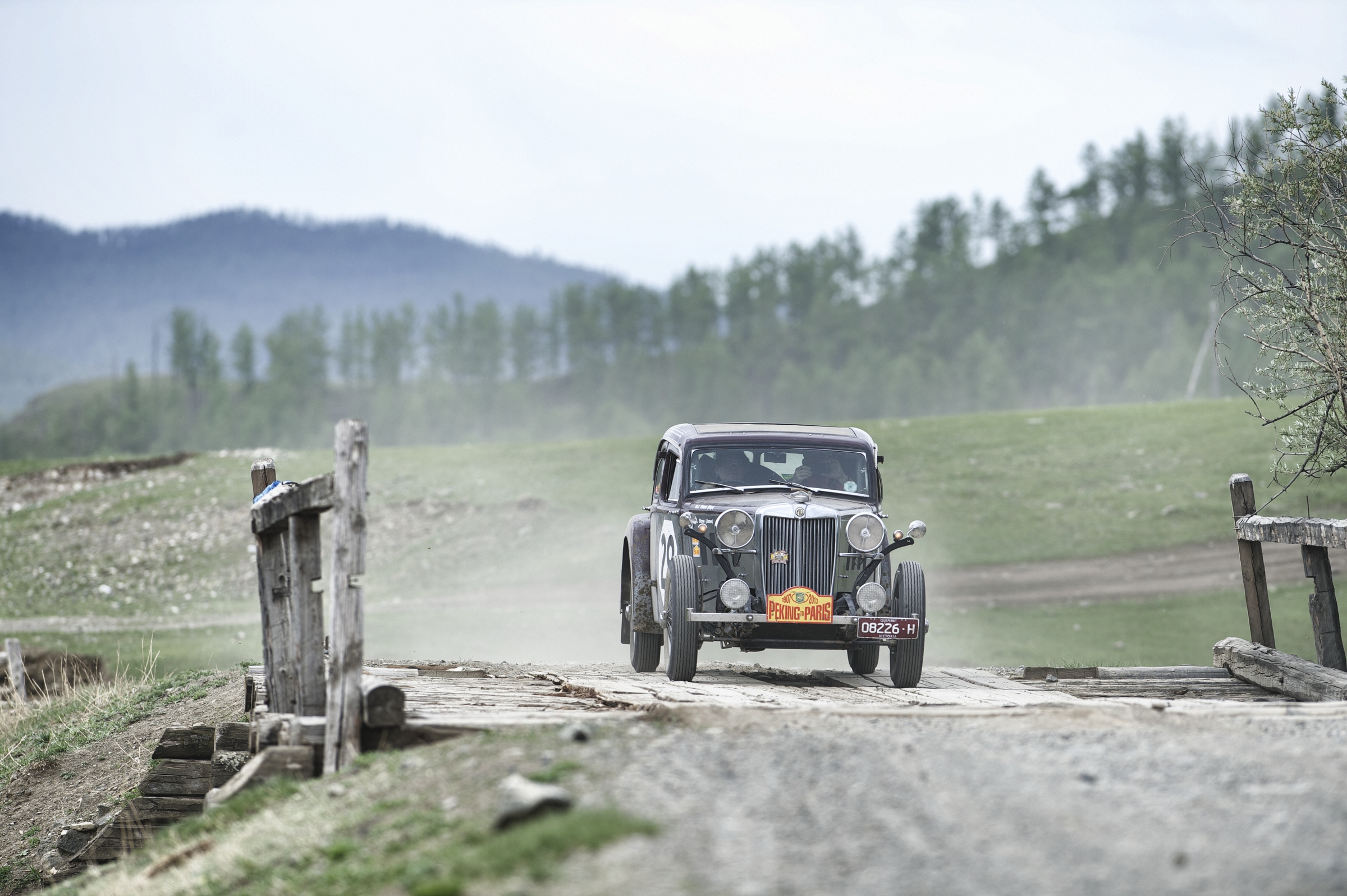
The two MGs hit Mongolia two days later without loss of penalty, and therefore technically equal first, with about 43 other Vintageant cars. From then on the rally became serious. Several special time stages, some up to 80 kilometres long, across the Gobi, no tracks, no roads, just desert. This sorted out the leader board pretty quickly. Two days of bashing, and we found ourselves with a rest day in Ulan Bator. As a team on the rest day, we headed out to get our repairs sorted, and the Udo came to the fore with his advice on preparation and mechanics as we set about making our cars desert worthy.
The damage to the field coming into UB was extensive, and the first of four rest days in the 33 day rally was welcome. The usual suspects of broken suspension, body parts, dust, axles and diffs really tested the field as we prepared ourselves for the rest of western Mongolia. We left about half a dozen cars behind in UB, not able to be driven in remote terrain, however the rally always moves on. There was talk of a number of withdrawals already, but information is always second hand and not always reliable. Rally rule number two – only believe what you see.
We headed off for another seven days in the Mongolian tracks, desert and steppes. In these conditions the two MGs were no different from the field. The SA lost its clutch at the end of one of those days and drove the rally sections the next day crashing the gears. The very fast TC made a decision in overtaking a slower car in one of the time trials in dust that forced it off lower into a mud pan, and required extraction and valuable loss of time. Both events were dark days for both crews.
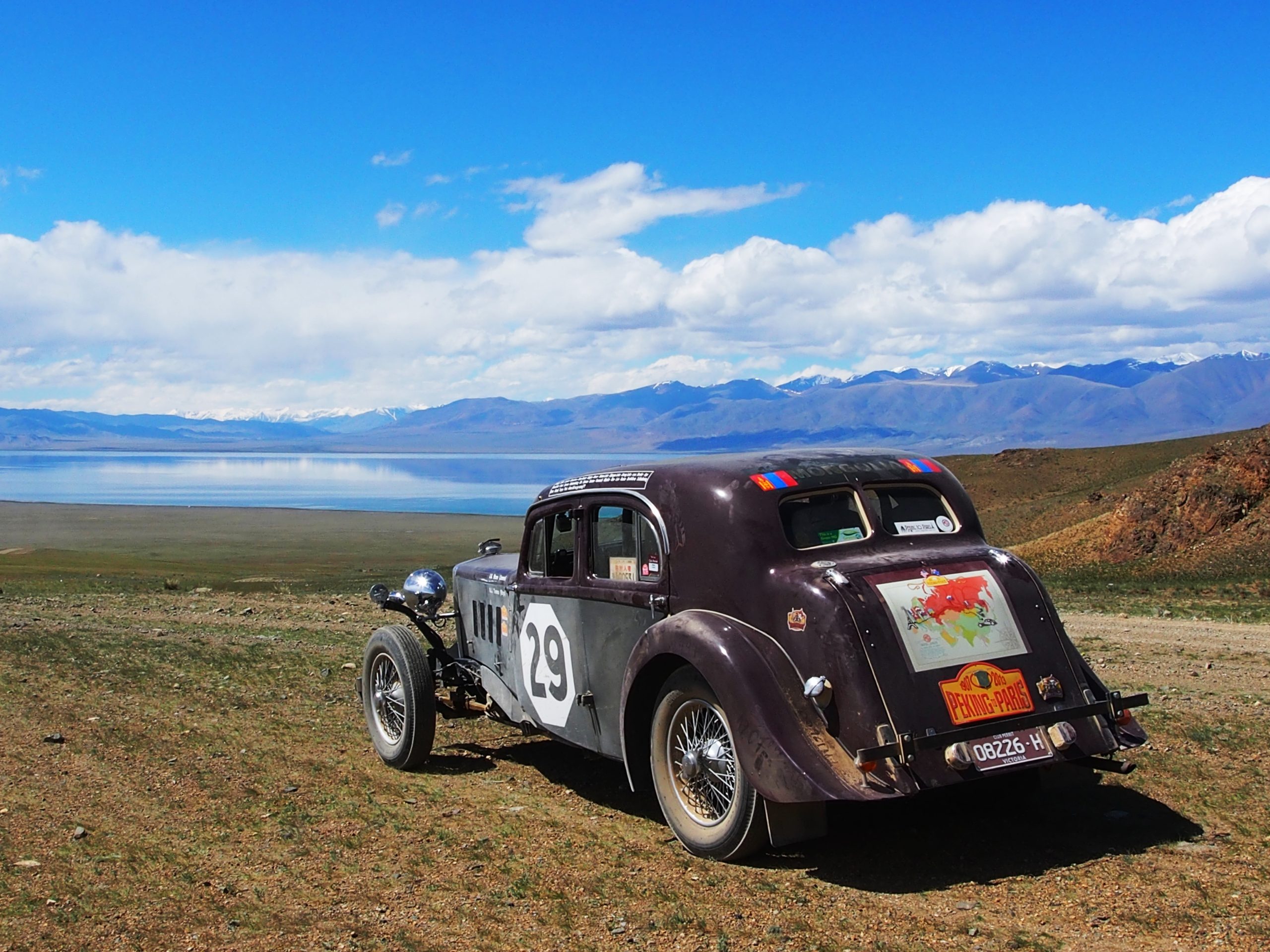
The dust in Mongolia was severe. We struggled with the SUs. They filled with the fine talc dust and performance suffered. At one hill climb, not in competition, we failed to climb a hill we would normally stroll up. Other cars reportedly drove up in reverse gear to make it up. In our run, we veered off the track to keep the revs up, and found ourselves floundering at a steep angle, sideways to the mountain, off piste and by all reports looked as though we had rolled. At the next passage control several minutes later, the paramedics were prepared for the rescue call to come back and deal with a rolled MG. To their surprise we arrived several minutes later to get our passage control stamp; they asked if any of us were injured from the roll they had heard about from several crews!
Camping in Mongolia is an absolute highlight. In military precision, dampened by Mongolian organisation… we camped out for eight nights with campsites usually next to lakes. On some of these nights we had tankers meet us at the lake, as there had been no fuel available in the remote areas for 100+ cars, including the organisation. Rally rule number 3, always fill up fuel before going to bed.
Whilst it is no secret that there are stars in the sky, it is still a wonder to camp under the stars, and actually see the stars by the millions with our naked eye. With temperate weather, it wasn’t too hot, and apart from the wind and dust at times – it really was five star camping. Hot showers and meals were available each night, and there was only one night I didn’t shower, that was the night when the shower tents blew over in a sandstorm, and it was easier to swim in the lake for a wash.
The day usually finished with a beer, and occasionally (regularly) the ‘must do’ service list each night was ignored in favour of the camaraderie in the mess tent which turned into a bar after dinner. We created a stir one night when James decided it was time to film the campsite, from 100 metres above us, from his RC helicopter. The go-pro strapped on, he buzzed the campsite with some magnificent aerial film footage.
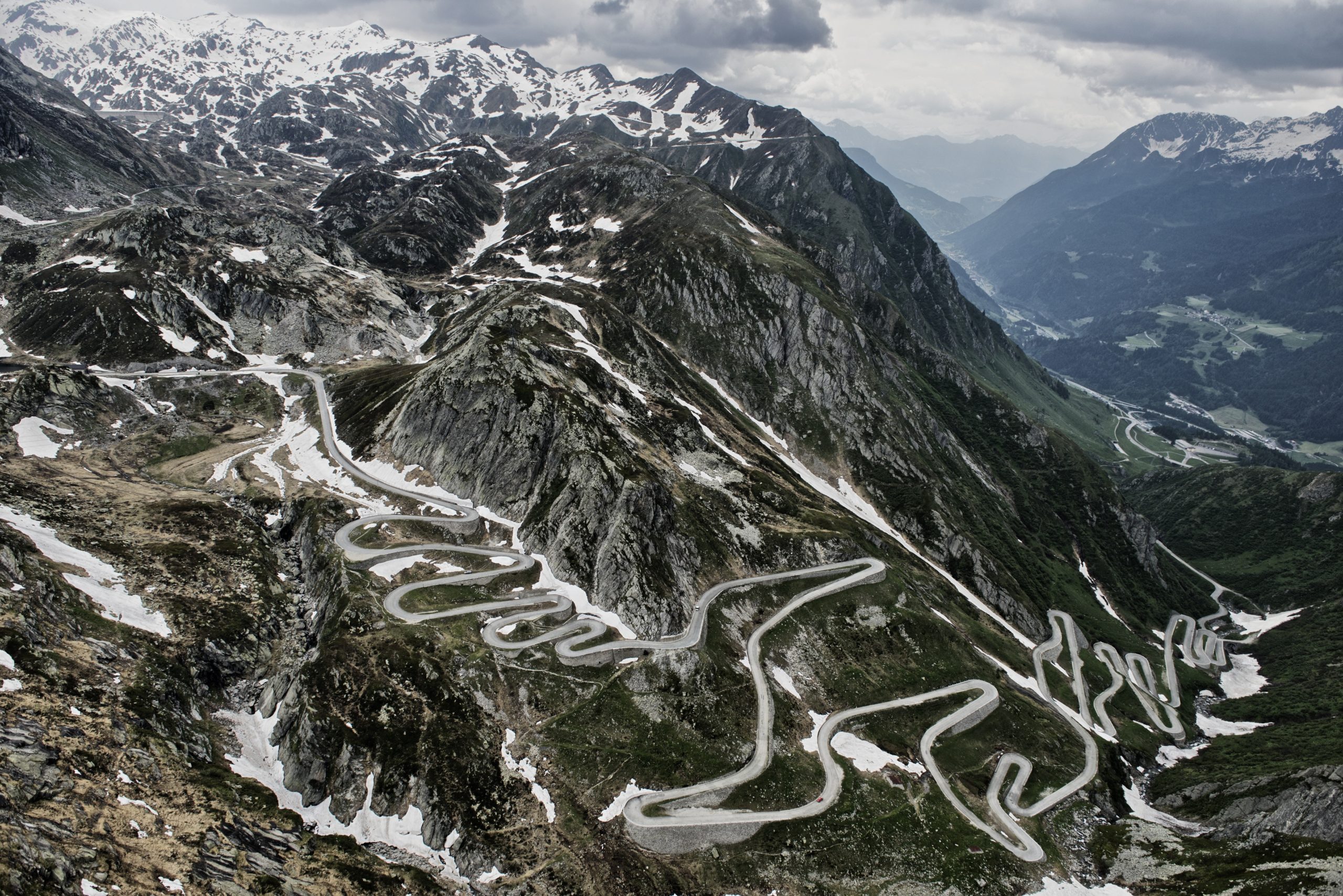
Bruised but not beaten, the MGs, undiminished, remained in the top half of the field and made it through to the second rest day, 1,000 more kilometres over the Russian border to Novosibirsk. This was day 14, nine days after leaving Ulan Bator, and the rest day was a misnomer, as really it was an extended full service day. Both cars suffered vibration damage, causing fatigue – with the TC losing is spare wheel carrier, and the SA cracking the diff housing at the exact point where the reinforcing gussets joined the diff.
The list of actual broken bits was extensive, but rally rule number four, always continue in a forward direction no matter what. The Altai region of Russia is also southern Siberia, and was generally acknowledged as one of the most visual highlights of the rally – after two weeks of dirt and dust, we descended into what could have been a Swiss rural scene, and in fact would not have been surprised to run into Vladimir Putin fishing or hunting as every photo was a fishing magazine postcard view.
In Novosibirsk, the extent of the damage to the rest of the field was more evident. Seven cars had withdrawn so far, not yet half way through the rally. Furthermore, reports were there were 10 more cars playing catch up that had fallen behind, but not really sure. In Mongolia, it was typical for up to 20 cars not to make it into camp each night, so this sounded right. Fortunately, we were still going strong. At this stage, one of the rally officials tracked down Peter. Peter’s original training was as a dentist, and this official had a very painful tooth and severe infection… and it looked for one minute as though there was going to be a tooth extraction with a set of multi-grips. The official had to take a stiff drink and lie down to think about it, and next morning was significantly better.
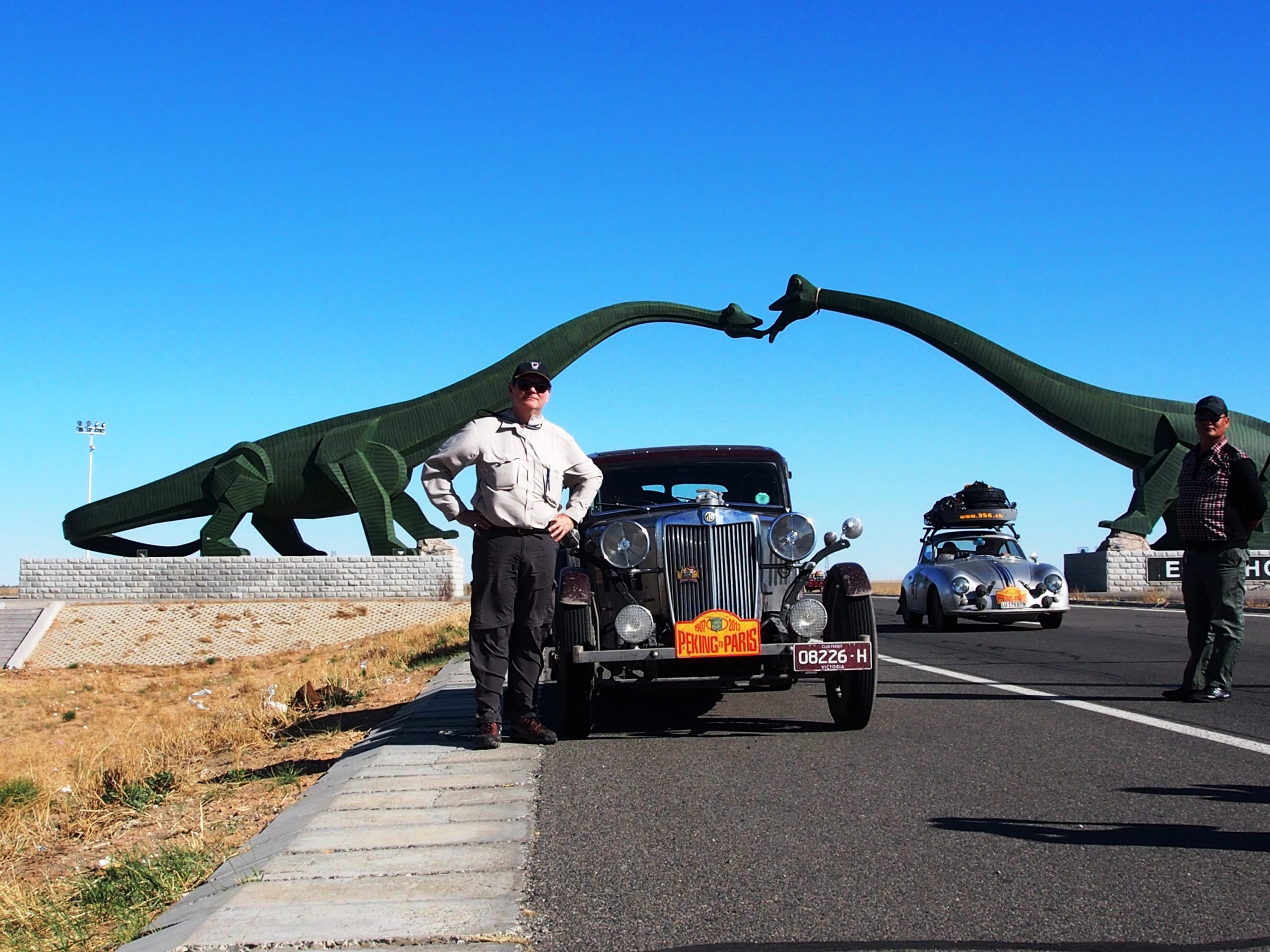
The Peking to Paris is no Sunday drive, especially when it is the Endurance variety. Most mornings start at 5.30 for a 6am breakfast, and time out between 7 and 8am. The better placed in the rally, the earlier you start, and both MGs were now starting within the first 15 minutes of each day. The days are long. Not excessively, but 10 to 12 hour days driving in a vintage car – for a week or more, with passage controls, time trials and track work. Usually the main time control at the end of the day is based in the hotel foyer, so we are often negotiating and navigating through foreign, yet the same, city traffic to get the time card stamped on time. As an endurance event, there probably is no longer motoring competition on earth.
Most of the fancier cars, the Bentleys and Rolls Royces, once broken down were out of the main competition and immediately changed their rally strategy just to survive and to get home. Only the hot rods, the all American prairie rompers which the organisers recommend are the car to win the pre war class, are usually out front (ie all steel, big motors, big suspension and loads of power, reflecting the difference in the English and American economies of the era). We had already passed a few of these beasts. A few other hot rods in front of us had gotten away with highway robbery through avoiding time penalties when on the receiving end of the tow rope of shame, however not penalised. Not that we knew at the time how well placed both of us were to be.
It was soon after this rest day that one of the rally cars was involved in a triple fatality. A local caused the head on collision in the early afternoon, on a good road, with one of our crews in a Chevy pickup. Unfortunately, one of our fellow rallyists, Emma Wilkinson, died instantly in this accident. Her partner, Peter Davies, was unhurt. The accident caused a huge amount of grief, not only for the other members of the rally and support crew, but for Emma’s brothers, who were also participating in an older Bentley.
All the timing and competition was cancelled that day and the following day out of respect, however we had to keep moving, as the rally was planned every single day. The mood was subdued for quite a while after this. We received a lot of sympathy from local Russians; the accident had been widely reported on TV and did not blame the rally car or rally organisation. At one unscheduled stop (we had water shorting our electrics – damn you Joe Lucas), a local clasped his hand, motioning from his heart towards us, indicating his heartfelt sorrow. We really didn’t have many communication problems when we travelled, using sign language, body language or recognised symbols, however this gesture needed no further interpreting.
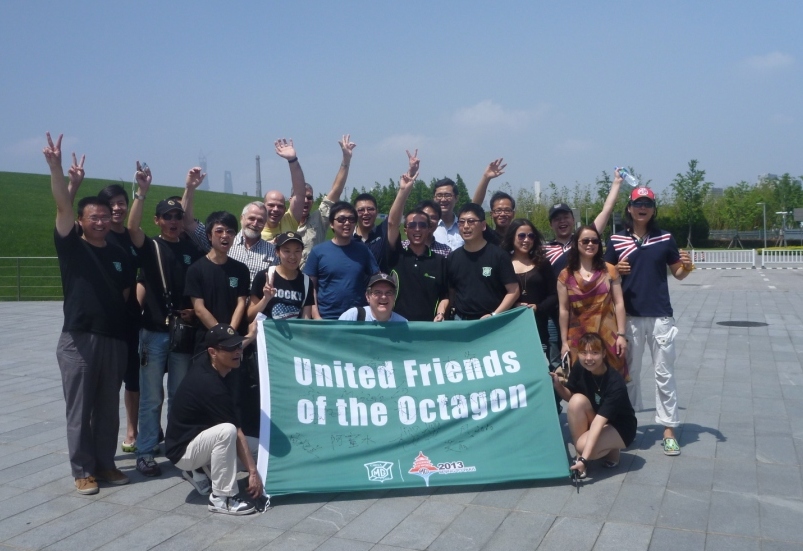
The welcome surprise for us was the warm reception we received all over Russia, and then the Ukraine. The rally had been covered by local TV news and everyone seemed to know our story, as well as the effort we had made to date. It was not uncommon to receive offers of assistance, refusal to accept payment. Our booty of MG badges had been accidentally left on the floor of a local Mongolian garage, so all we had to offer was inexpensive bumper stickers.
What helped greatly was a large map and symbols of our journey on our boot, and the names of the towns on the side of car which Peter had printed. Our website had a dedicated Russian language page explaining who we were, what we were doing, and general facts about the rally. Each day, another 600 or more kilometres westwards, heading for the Ural mountains and the divide between Asia and Europe.
In the Ukraine, we were treated like rock stars. Not only did competition re-commence in earnest, but each night we had a public reception with the support of the major auto club in the Ukraine. On our last rest day in Kiev, we had time to change our oil again, and where else but the local MG dealer, of course. Oh, a small MG world. On the last night in the Ukraine, we were welcomed into the Lviv town square, driving three metres up onto a stage in a large marquee as a rock band played us on, and were individually introduced to the crowd to huge applause, still reminiscing after such brilliant great roads, towns and people. After we had all arrived, a local concours condition MG TD was parked up on the stage for the rest of the night as part of the weekend motoring festival.
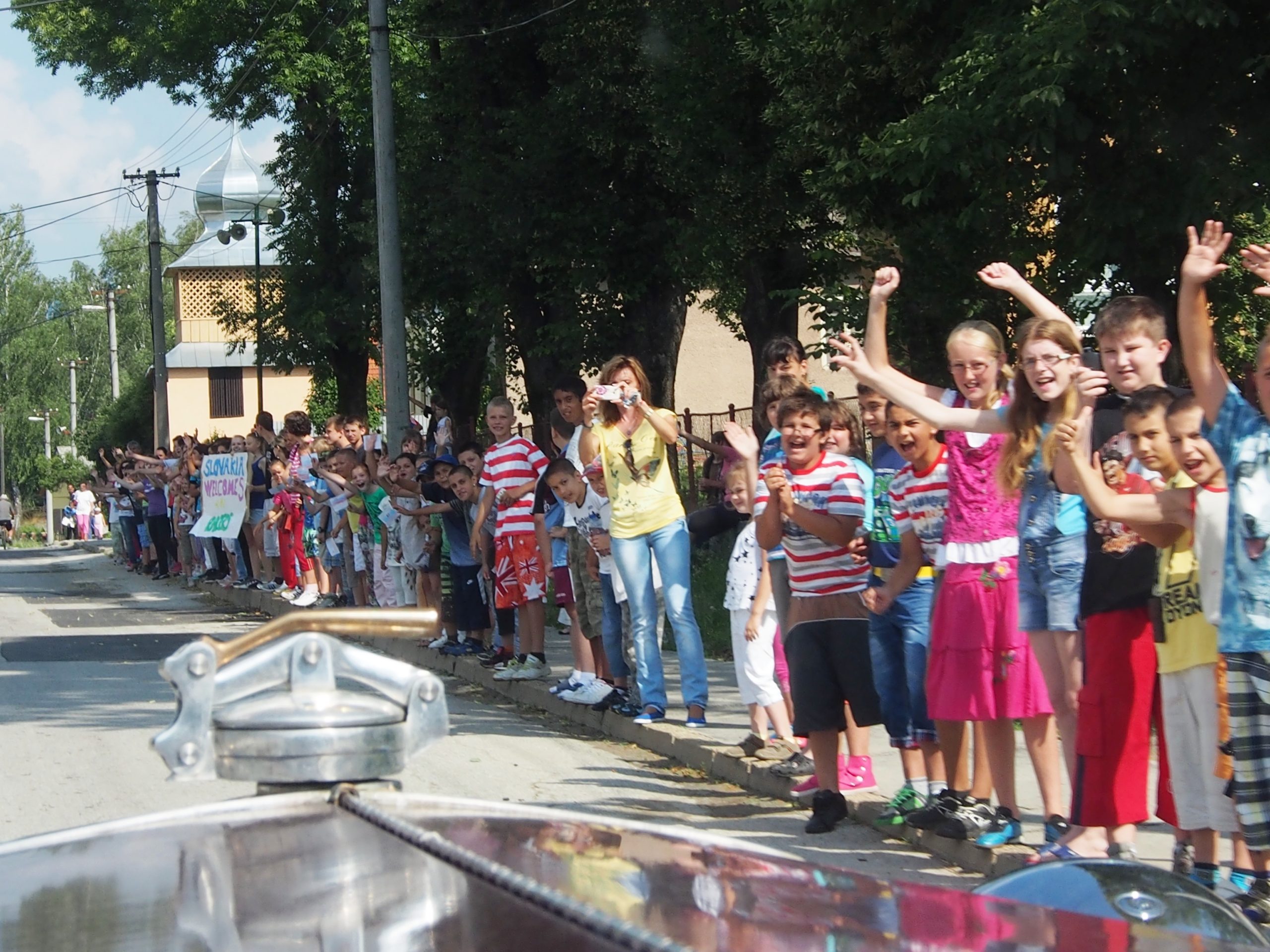
Through to Slovakia, Austria and Switzerland – where we thought that the rally would step up a notch in non rally refinements. Well it did, and we had to earn it. There were now eight days of hard driving in front of us to make it to the finish. Remember the rally rules? A hard day in Austria – we were following the car in front of us, had lost our position in the tulip book, run low on petrol after not refuelling the night before, asked locals for information where to get petrol, and went the wrong way based on their (dis)information, significantly the wrong way as it turns out – all to find ourselves unable to fuel with an auto filling bowser…. so in our weary state, we broke rally rules indiscriminately from number one through to number four, all in about 20 minutes…. but for the gps receiver, sat nav, map, route book (no road or town names) and an extra tablet loaded with maps and gps connectivity… we madly scrambled our way home navigating on the fly through several villages and luckily a motorway brought us back to the next passage control just in time. New rally rule number five-stop making rally rules if we are not going to follow them.
We had a full on assault for four of those days, making approximately 16 alpine passes. The stress of the alpine stages really smashed the field wide open. We lost seven minutes in these four days, but didn’t really put a pedal wrong. Our four wheel drum brakes suffered brake fade on two of those days; we serviced the brakes once ourselves, and then sought professional assistance in rebuilding the best of what we had. One of our brake pads had disintegrated, with the heat likely to have melted the glue binding the pad onto the shoe.
The other rear brake had been fouled by a leaking diff seal. The rally mechanics taught me a valuable lesson in recovering an oil fouled shoe – we burnt off the excess oil by holding a brake pad BBQ in one of the most exclusive ski resorts in Switzerland. Interestingly, we passed a circus of Midgets (is that the collective noun for MG Midgets?) in the Alps, as one of the many car and bike rallies that we passed on our way. Sorry MG family, only waved – couldn’t stop!
There were 26 nationalities represented in the rally. As an international rally, we travelled all too quickly through the cities and nine countries on the route. We did not, and could not, stay long enough in any one place to truly appreciate every town or region. However, unable as we were to spend time with the locals, we were able to establish close friendships along the way with those 96 crews that we ate breakfast with, dined with and followed their dust every day, or vice versa. Another highlight was the friendships made in this time, rally buddies that we won’t see much outside our own countries of origin, but – the power of email and social media, we are still bonded (albeit electronically) from every corner of the world. Even the MG team.
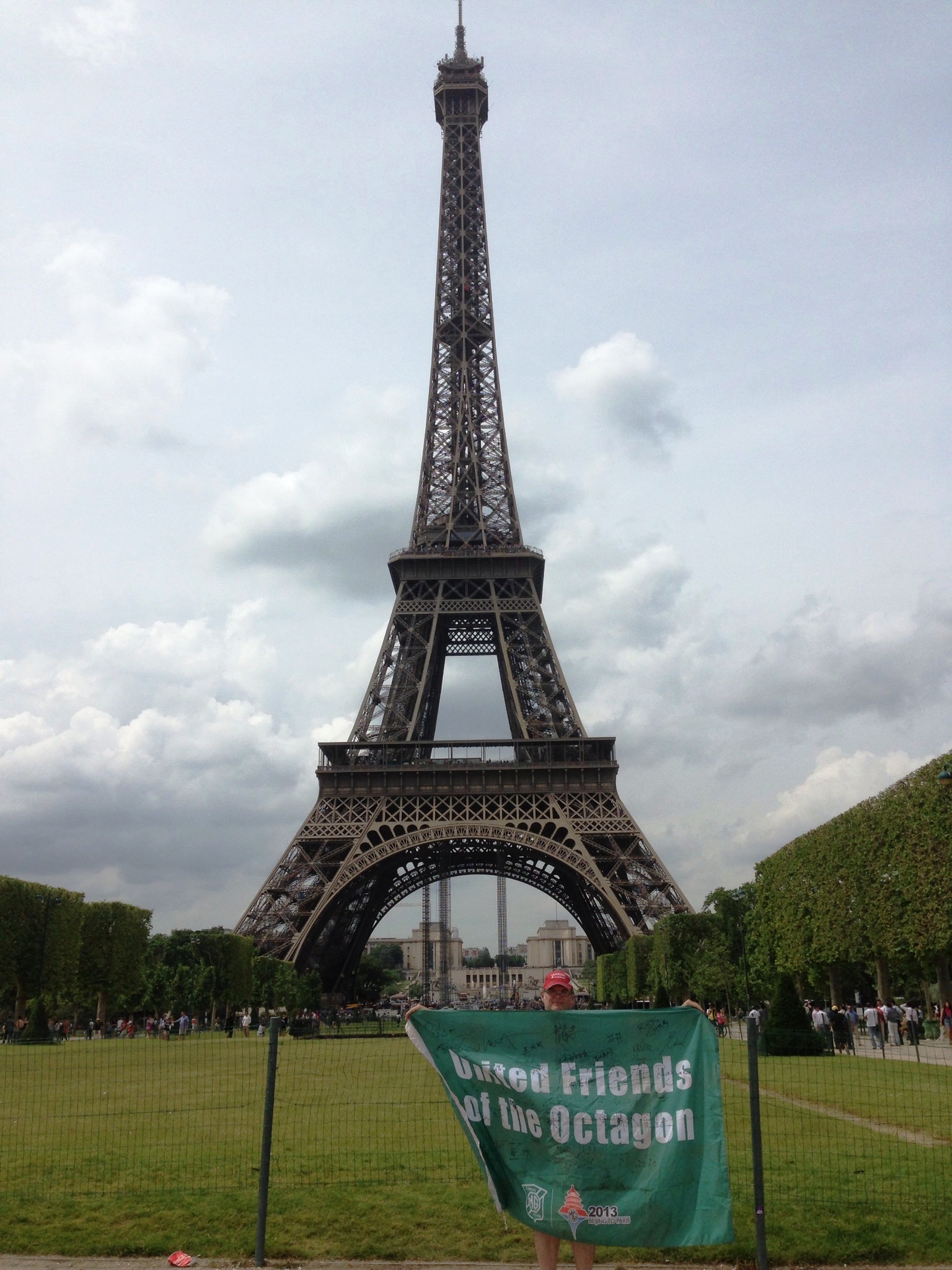
The MG marque of friendship continued at this overnight stop in Gstaad. An onlooker introduced himself to me, and mentioned he had a TD and a B in his garage at home. He was very pleased to chat about MGs, but alas, he was aged, getting in and out of the low slung MGs became problematic given his knees, and he didn’t really use them much. I offered him a ride in the SA, as it was late – and I had an ulterior motive: I needed to refuel in town – and not only did he leap at the chance (or slide comfortably into the luxurious sport saloon), he navigated through town, gave a short oral history tour, and then offered to pay to fill the tank. I couldn’t accept his kind MG offer of generosity; I was as happy to have a guide, as he was for a joyride.
Through completing every day in regulation, both MGs accidentally found themselves in the top 10 in the Vintageant category. Other cars had fallen away due to damage sustained in Mongolia, others subsequently when tested in the pressure test of the Alps exacerbated earlier damage. At the last competitive event, a time trial which was two laps run on a short track, we threw caution to the wind. We unloaded the car of the spares and went for it to make up another place by 11 seconds. The tyres smelt a bit warm, but we did well. Peter in the TC scorched the track with fastest time of the day.
The final day was penalty free, just make the 210 kilometres into Paris without incident, cross the finish and see the family for the first time in six weeks. A bulletin was also posted on the MG Club de France advising them to watch out for us as we approached Paris. Extra care was taken with the navigation and driving in Paris; the roundabout at the Arc de Triomphe was very quiet and we were one of the first groups of cars in at the final Main Time Control, and the finish at Place Vendome. Both MGs travelled in convoy through Paris and over the finish line together, and we proudly displayed our MG United Friends of the Octagon flag presented to us by the MG CCC, and flown some 33 days earlier at the Great Wall of China.
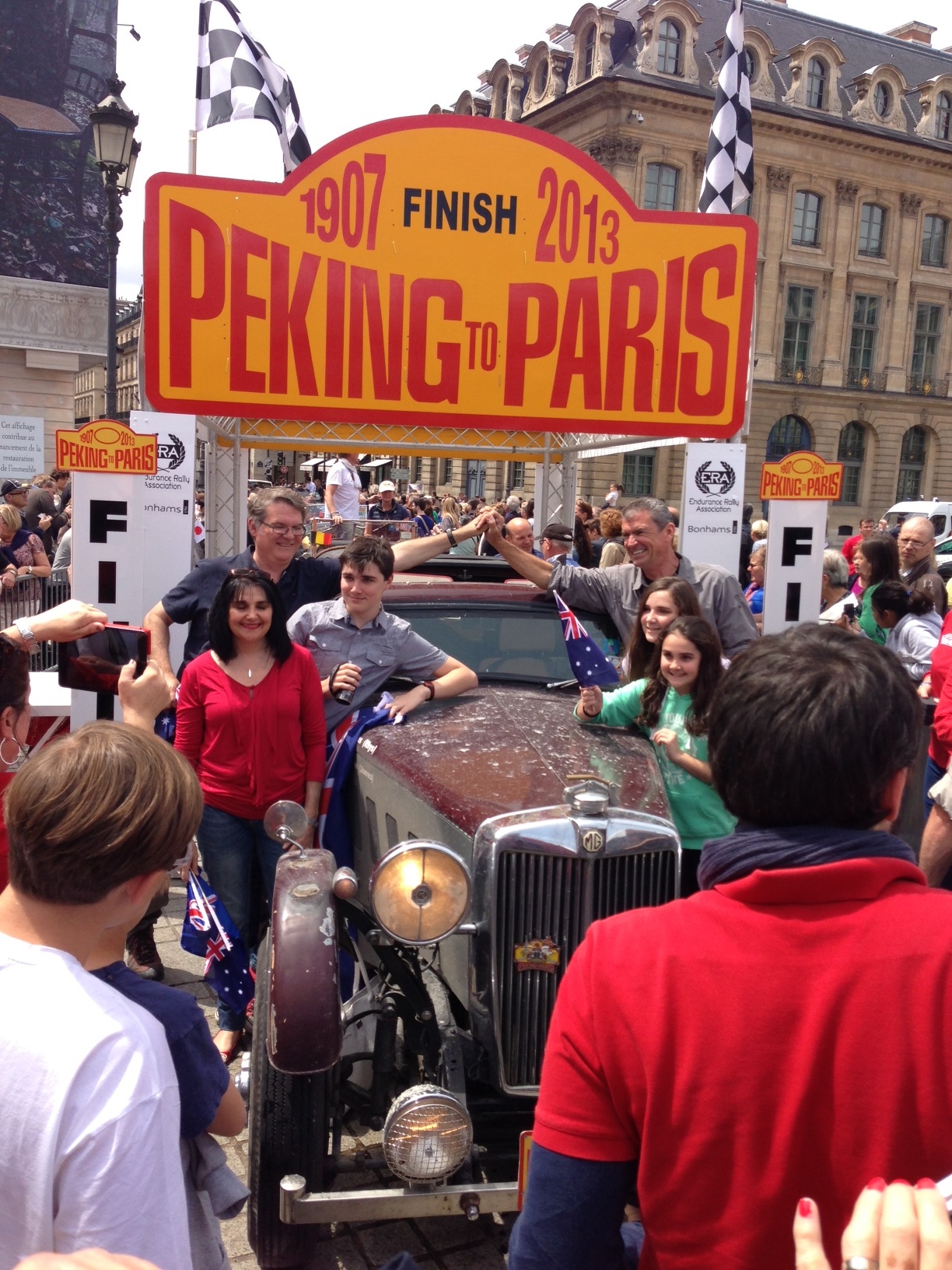
Both MGs did remarkably well, easily placed in the top 10 despite the diminutive power/weight handicap. They are old cars, as were half the rally, although did better than 75% of all the other cars in the rally including moderns. Peter and Udo had one of the best prepared cars in the whole rally, and despite setbacks along the way, their ability to effect major repairs to keep going forward every day was remarkable. Rhys and James, with some experience behind them, were even placed well enough for a minor trophy.
The MGs were built in a time when simplicity was the criterion for reliability (except electrics), and fun was embodied by the little sports car, or even the stately gentleman’s sporting saloon. There is no reason why our cars can’t still be enjoyed today in all conditions. The pair of MGs travelled two continents from West to East in a ‘don’t stop for no-one’ rally, through deserts, ice, mountains, race tracks and setbacks – spreading the MG friendships from MG clubs and members, MG dealers, MG mechanics and even former owners of MGs – the true marque of friendship.

 MG Car Club
MG Car Club